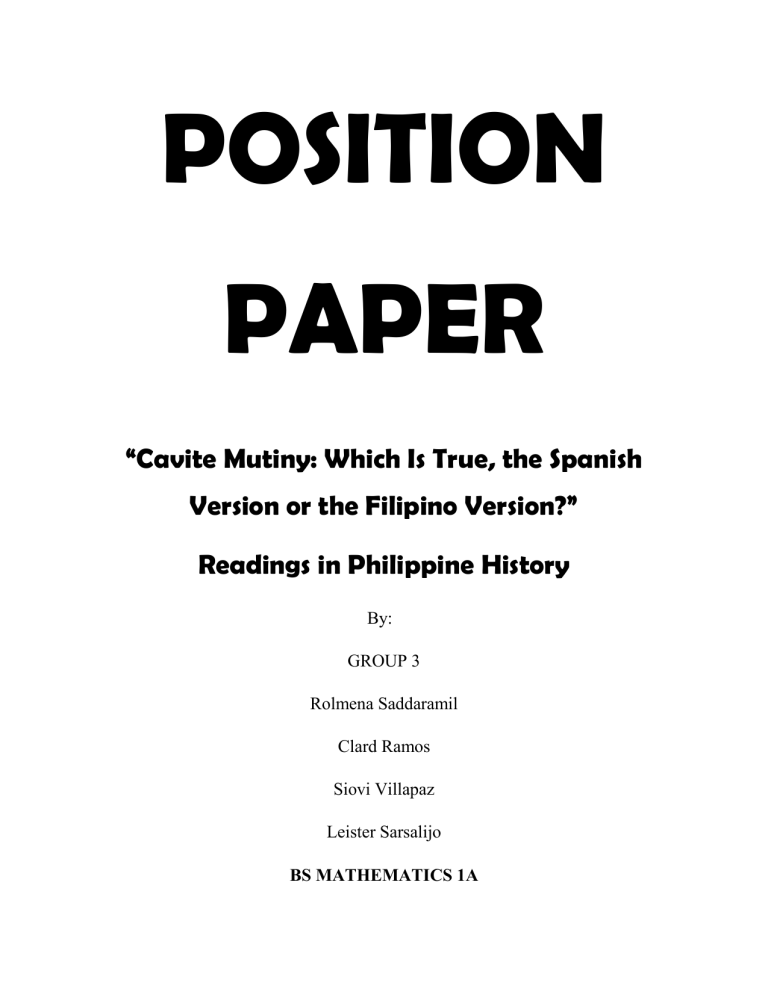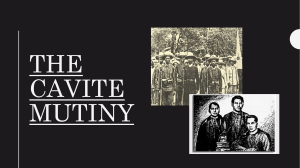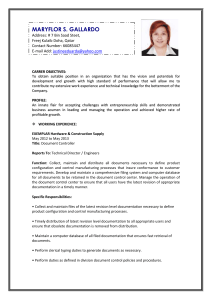
POSITION PAPER “Cavite Mutiny: Which Is True, the Spanish Version or the Filipino Version?” Readings in Philippine History By: GROUP 3 Rolmena Saddaramil Clard Ramos Siovi Villapaz Leister Sarsalijo BS MATHEMATICS 1A INTRODUCTION Studying history portrays a big role in our life. History helps us to understand the past to predict the future. We can look back to the history if we want to know what leads us to the present. This position paper will discuss about one of the tragic event happened in the Philippines, the Cavite Munity. Cavite Mutiny – happened January 20, 1872 – a brief uprising of 200 Filipino troops and workers at the Cavite arsenal served as an excuse for renewed Spanish repression. Ironically, the harsh reaction of the Spanish authorities served ultimately to promote the nationalist cause. The uprising was used by the Spanish colonial government to implicate and sentence to death by garotte Fathers Mariano Gómez, José Burgos and Jacinto Zamora on February 17, 1872 in Bagumbayan, and several other Filipino leaders. These executions, particularly those of the GOMBURZA, were to have a significant effect on people because of the shadowy nature of the trials. Dr. Jose Rizal dedicated his work, El Filibusterismo, to the executed priests. Many scholars believe that the Cavite Mutiny of 1872 was the beginning of Filipino nationalism which eventually led to the 1896 Philippine Revolution. (Philippine News Agency archives, 2012) The Cavite Mutiny has two existing versions comes from the two opposing side, the Spanish and Filipino. Thus, we chose to defend the side which was pointing that it happens due to the concerted efforts of disgruntled native soldiers and laborers of Cavite arsenal who willfully revolted to overthrow the Spanish rule. The Spanish version of Cavite Mutiny of 1872 was written by Jose Montero y Vidal. BACKGROUND “Jose Montero y Vidal, a prolific Spanish historian documented the event and highlighted it as an attempt of the Indios to overthrow the Spanish government in the Philippines. Meanwhile, Gov. Gen. Rafael Izquierdo’s official report magnified the event and made use of it to implicate the native clergy, which was then active in the call for secularization.” (Piedad-Pugay, 2012) Thus, the main reason of the so called “Revolution” is that the privileges enjoyed by the laborers of Cavite arsenal have ended. Anyhow, the native clergy by its presence conspired and supported the rebels against the Spanish Friars. Izquirdo report it to the King of Spain saying that they will replace a new “Hari” in the likes of Fathers Burgos and Zamora. As he also stated “native clergy attracted supporters by giving them charismatic assurance that their fight would not fail because they had God’s support, aside from promises of lofty rewards such as employment, wealth and ranks in the army”. They thought it as a big conspiracy among educated leaders, mestizos, abogadillos or native lawyers, residents of Manila and Cavite and the native clergy. They insinuated that the conspirators of Manila and Cavite planned to liquidate highranking Spanish officers to be followed by the massacre of the friars. The alleged preconcerted signal among the conspirators of Manila and Cavite was the firing of rockets from the walls of Intramuros. “The idea of attaining their independence, it was towards this goal that they started to work, with the powerful assistance of a certain section of the native clergy…,” an excerpt from Montero’s accounts in Cavite Mutiny. His account was said to be and was criticized as woefully biased. Hence, we believed that the Cavite Mutiny was a grand conspiracy. We consider that the abolition of the privileges enjoyed by the laborers of the Cavite arsenal and it causes the insurrection as it is stated. We shall not just focus in an argument that the mutiny is a labor issue and this leads to a widespread uprising of the Filipinos. If we dig further, the GOMBURZA was executed because they were blamed as the masterminds of the Cavite Mutiny not because of labor issues. The GOMBURZA were convicted guilty by the fiscal for being the defendants, this is why it is a grand conspiracy. But then the prosecutors used the interpretations of Gov. Izquirdo that the three priests was the cause of the uprising because of the circulation of the events. Now, it then leads the labor issue be a weak argument that Cavite Mutiny happened and that the Spanish version was true. CONCLUSION The natives aim to get rid of the Spanish Government since the privileges enjoyed by the laborers of Cavite arsenal had removed. But the native clergy supported the rebels against the Spanish friars. Laborers commit their uprising due to labor issues; however the mutiny happens to be a grand conspiracy. Besides the friars knew in advance of the mutiny and they plotted it to assert to Spain their importance to the Colony. Montero’s account centered on how the event was an attempt in overthrowing the Spanish Government in the Philippines. The GOMBURZA was publicly executed so that it will serves as a lesson. They were executed because they became the masterminds in this mutiny. In addition, many Filipinos were sentence to deaths because they became part of the revolution. Izquirdo had requested the sending of the Spanish troops to Manila serves as defense of the fort as most of these found here were natives. Through defending this version, we had surely learned that every stands and document should not be biased because it might weaken the theory you are proposing. That it should have stands in both side of the opposing team not just one-sided. But we also know, even unbiased documents could still have flaws and can be crashed by a strong theory. Even though Jose Montero y Vidal’s version was criticized a woefully biased, he was also one of the most knowledgeable of the Spanish historians of the Philippines. For us, the Spanish version of Cavite Mutiny was true and it happened because of the Grand Conspiracy that firmly caused the uprising which deals with the Spanish perspective. Reference: http://nhcp.gov.ph/the-two-faces-of-the-1872-cavite-mutiny/ https://kahimyang.com/kauswagan/articles/891/today-in-philippine-history-january-201872-the-cavite-mutiny-took-place Grey, Evelyn (201 7), Readings in Philippine History. Student’s Edition.




